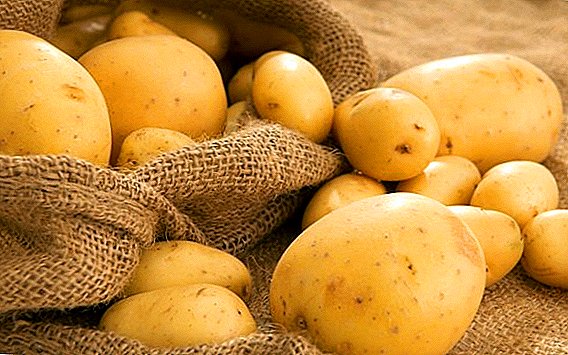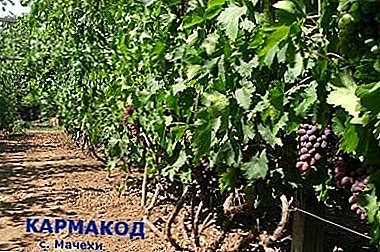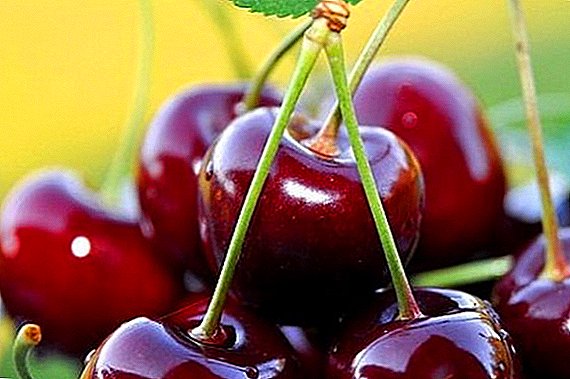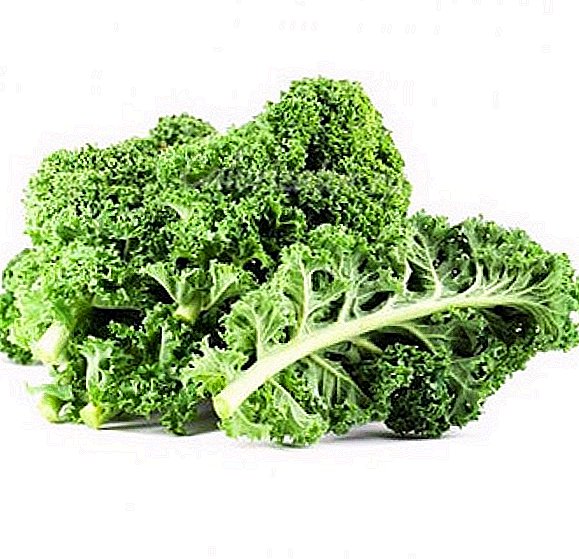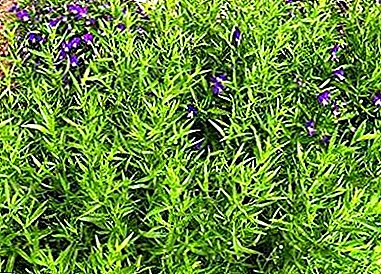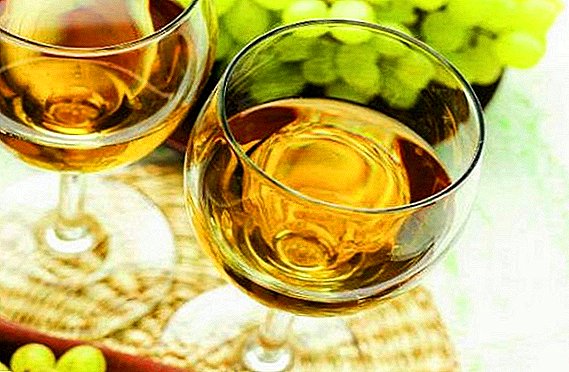 Home winemaking is still in trend. Many believe that the hand-made will be better than the "shop", but the process itself is important to someone. And each has its own secrets and tricks to help get a quality drink. Let us try to summarize the experience on the example of dry white wine of our own making.
Home winemaking is still in trend. Many believe that the hand-made will be better than the "shop", but the process itself is important to someone. And each has its own secrets and tricks to help get a quality drink. Let us try to summarize the experience on the example of dry white wine of our own making.
Homemade dry wine
For the manufacture of dry wines used only grapes - sugar is not added. Even if such a need arises, its content in the final product does not exceed 0.3%.
Another difference from the dessert lines: in addition to low sugar content, the berries should also be slightly more acidic.
With the observance of "home technology" is obtained a drink with a maximum alcohol content of 11-12%. Its taste favorably differs from dessert types by its delicate aroma and delicate taste. In addition, this product is easier absorbed by the body.  Amateur winemakers are not too fond of dry types of drink, considering them difficult to obtain. Although this technology does not hide any special tricks, as you can see for yourself.
Amateur winemakers are not too fond of dry types of drink, considering them difficult to obtain. Although this technology does not hide any special tricks, as you can see for yourself.
The most famous product of grape processing is raisins. Learn how to make raisins at home.
Selection of grapes
Dry white wine produced by processing ripe grapes of light varieties. Note that their sugar content is 15-22%.
Of exceptional importance is the ripeness of the berries. The fact is that immature fruits contain little sugar, and the fermentation of the wort will have to be stimulated by quite large amounts of sugar.  The process will go faster, but in the end, the drink runs the risk of losing its taste. That is, the dry wine will turn into something like a dessert.
The process will go faster, but in the end, the drink runs the risk of losing its taste. That is, the dry wine will turn into something like a dessert.
Important! The type of soil directly affects the sugar content of fruits: in grapes grown on sandstone, it is always higher than in plants planted in black soil.
What varieties fit
The drink is recommended to prepare from the lines, which are characterized by a light aroma, coupled with impatient taste. These requirements are best met by such varieties as:
- Aligote;
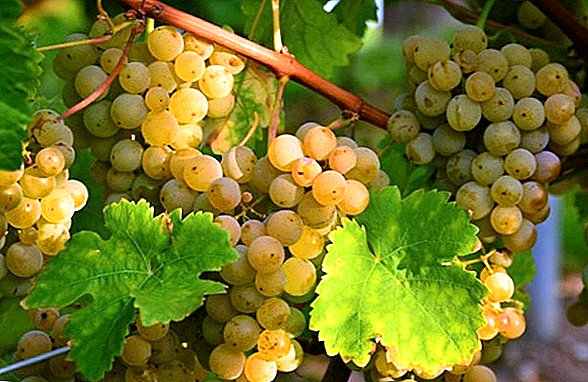
- Bianca;
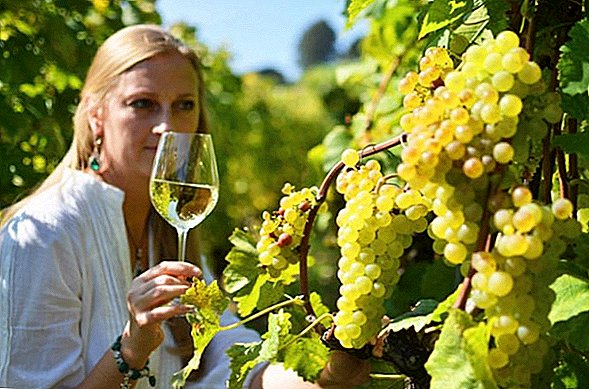
- Viognier;
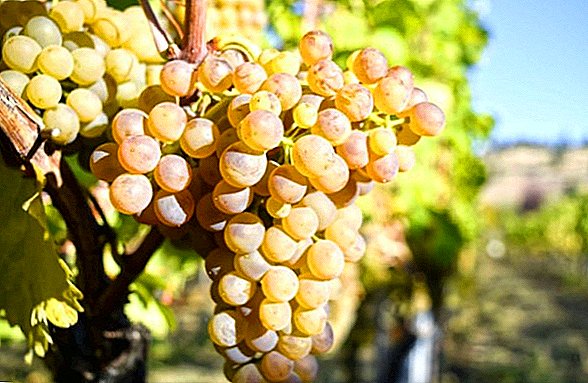
- Riesling;

- Sauvignon
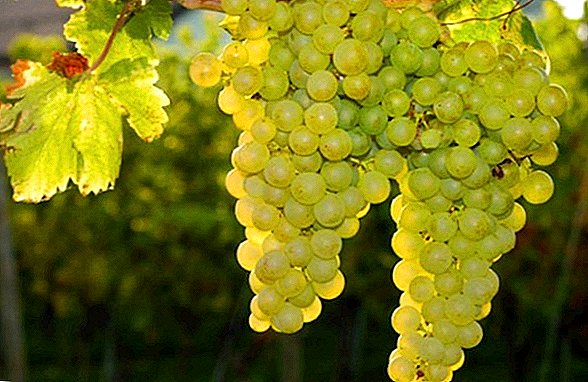
But in our area the most massive is White Muscat, and most of the amateurs work with it. True, its strong pleasant aroma requires special attention during processing.
Check out the best varieties: early, nutmeg, table, white, pink, black, cold-resistant, unopened and technical grapes.
Berry requirements
The berries themselves must be whole. Mold, mechanical damage and signs of disease are excluded. The same applies to the "mesh" in the form of thin hardened veins on the skin.
It happens that on the grapes are visible thick layers of web: such raw materials are also not suitable.
Experienced winemakers pay attention to the size of the fruit - abnormally large, as for a particular variety of berries lay aside. They may be over-ripe or too watery. 
How to cook wine: cooking at home
Having figured out how dry white wine differs from drinks of other lines, we turn to the description of the process of its preparation. Let's start with the collection.
Berry preparation
Suitable clusters are collected in dry sunny weather. Sorting is also carried out here - the diseased and damaged berries are separated. It is better to do it right away: having collected a large amount of raw materials, it is no wonder that such fruits are missing, which is undesirable for the future of the wort.
Read how and when to pick the grapes.
Please note - after collecting the berries do not wash (so as not to wash off the natural yeast). The remaining dust particles are still neutralized during processing.
If it is rainy outside, it is better to refrain from collecting: drops will wash away the natural substances that help the grapes during fermentation from the skin. Crafty and drizzle - it can start the process of decay.
After this, the first stage of work begins, namely the separation of berries from the ridges. The fruits themselves are torn off and placed in a suitable container (pot, bucket or large bowl).  Separating berries from crests This procedure requires time and care - the remnants of the "legs" should not get into the workpiece.
Separating berries from crests This procedure requires time and care - the remnants of the "legs" should not get into the workpiece.
The crest in the wort provokes oxidation: the juice darkens and acquires bitterness. The output is no longer dry, but an ordinary dessert wine, so make sure that you get into the container.
Important! Cutting off the clusters, look at whether there are traces of insects on the berries and crests. These barely noticeable lesions can be a focus of fungal diseases.
How to crush berries
Many people associate this stage with shots from the cinema, in which farmers climb into a huge vat and crush their grapes with their feet. It looks spectacular, but not too practical, especially if it happens indoors.
At home, there are several ways:
- manual processing. Thoroughly washing hands and wearing rubber gloves, proceed to the process. Crush slowly, keeping hands close to the bottom of the tank under the wort. Despite its simplicity, the method is effective for working with small volumes of raw materials (up to 15 kg);
- mechanical. A simple press is used - wooden millstones with a handle are connected to a tray. Fruits fall asleep into it, and the product is pressed through a special opening. Simply and reliably, moreover, the spray does not fly so actively;
- popular and crush electric mixer. It's simple: put a mixer under the putty (of course, clean) on the drill and squeeze the grapes, alternating smooth passages down and circular movements from the center of the tank to the sides. At the same time keep small or medium speed drill.

You can also crush the grapes with a crusher.
All of these methods have both advantages and disadvantages. With the manual method, everything is clear: the quality of the pulp is achieved by careful processing.
The press speeds things up, but many avoid it, it is reasonable to notice that in case of an error in the effort, this device damages the bone (and this is a violation of technology).
In turn, the mixer requires a fair amount of exposure when working with large volumes - hands get rather tired.
Did you know? In ancient Rome, wine was considered a product of mass consumption, although the law forbade women to drink it.
Fermenting wort
Fresh wort is checked for the absence of whole berries. If they show up, they are crushed by their hands. Further work is carried out according to this algorithm:
- The wort is placed in a container with a wide neck. (ideally an enamelled bucket or pan) and insist day at a temperature of + 18 ... +22. Tara is covered with a wide gauze. At this stage, many do it easier, pouring the wort in a tightly closed container.
- After this period, the juice is separated from the pulp by expressing. To do this, take a dense gauze.
- The resulting liquid is drained into a bottle with a wide neck. (the pulp is left in a separate container - later even 50% of the juice will come down from its mass).
- After this, the containers are tightly closed with a hydraulic lock.. They are used in the active fermentation phase, and when the process becomes less turbulent, ordinary gloves are worn on the neck. To prevent the ingress of oxygen inside, cover the lid with scotch tape.
- Billets put in a warm place. Active fermentation takes 30-35 days.

Important! Fermentation tanks filled with juice at 2/3 of the total volume.
After waiting for the set interval, fermented wine is removed from the sediment. This is done by gently overflowing the juice.
If there is a lot of pulp left, a flexible transparent tube is taken - one edge is placed in the juice, breaking a layer of fermented berries, and the second is taken out to a clean container.
As they empty, the first bottle (it stands higher all the time) is gently tilted.  Then be sure to check the juice to taste. This is a kind of moment of truth: if the sample indicates increased acidity, then the grapes are not quite suitable for making a white dry drink.
Then be sure to check the juice to taste. This is a kind of moment of truth: if the sample indicates increased acidity, then the grapes are not quite suitable for making a white dry drink.
Also, homemade wine can be prepared from: chokeberry, gooseberry, plums, apples, raspberries, black currants and rose petals.
But this is no reason to despair - you can get out of the situation in two ways:
- radical (adding 150 grams of sugar to 3 liters of wine). Although the drink produced in this way is no longer considered a "pure" dry wine;
- using inverted sugar. For 1 kg of sugar take 0.5 liters of water. The mixture is heated to 90 degrees, and then 3-4 g of citric acid are added. All this is boiled for an hour, and after cooling it is added to the juice in small portions (do not forget to taste it).
After adjusting the taste, the containers are covered with a glove or an improvised water gate (the same tube is inserted into the cork, the other end of which is placed in a 1-liter jar of water - this is how excess air flows)  Tara sent for ripening. Suitable locations are a cellar (where it will take a month at + 12 ... +15 a month) or a corner with + 16 ... +18, in which the process may take a day or two less.
Tara sent for ripening. Suitable locations are a cellar (where it will take a month at + 12 ... +15 a month) or a corner with + 16 ... +18, in which the process may take a day or two less.
Did you know? German winemakers are increasing the production of so-called ice wine - a dessert drink made from berries frozen on a vine.
Do not forget to inspect the wine and once every 1.5-2 weeks to remove the sediment by regular draining into a clean container. At the same time, taste is checked. Toward the end of the month comes another important point that deserves a separate description.
Crumbling
Tartar is an acid that crystallizes and deposits on the bottom and walls of the container. Such fermentation products resemble sugar particles or fine broken glass. It is harmless and does not affect the taste. Novice winemakers often fear it, but in vain - this indicates the quality of the drink.
To intensify the loss of tartar, containers with wine are sent to the basement, previously wearing a glove on the neck. After 20-30 days the final precipitate will form. Of course, during this time you will have to periodically inspect the drink, assessing its color.  Tartar in the form of sediment After making sure that the crystals fell out completely and new layers did not follow, you can make the final removal of the sediment and start pouring the wine.
Tartar in the form of sediment After making sure that the crystals fell out completely and new layers did not follow, you can make the final removal of the sediment and start pouring the wine.
Did you know? The oldest wine was bottled in 1300 BC. in China. So dated their discovery in the form of two bottles by archaeologists who conducted excavations in Chinese Xinyane.
Spill and plugging
The volume and type of container for the finished drink does not matter. These can be bottles or bottles of different sizes. Although there is a slight nuance regarding the material. For a young wine that is poured into bottles, light glass is preferable.  Plastic, which is now popular, is also quite good, but here everything depends on the quality - the bottle that was just bought may slightly hinder the taste of the drink (the factory compounds used in the manufacture of containers do not always disappear). The plug is filled with a conventional screw cap (in the case of a bottle) or with the use of oak plugs that are suitable for the diameter.
Plastic, which is now popular, is also quite good, but here everything depends on the quality - the bottle that was just bought may slightly hinder the taste of the drink (the factory compounds used in the manufacture of containers do not always disappear). The plug is filled with a conventional screw cap (in the case of a bottle) or with the use of oak plugs that are suitable for the diameter.
Important! When pouring into glass bottles, dry and disinfected champagne containers are commonly used.
What to do if the wine is cloudy: ways to lighten
The original color of fresh wine is no different noble. But it is fixable - in such cases resort to the help of clarification.
Any winemaker will say that the natural method is preferable. The procedure is long: the bottle insists in the basement up to 2 years before the drink gets a spectacular color.
Despite this duration, it is recommended to use this method - this way even the most turbid liquid is transformed. There are other, more radical and speedy methods. It is about the use of various additives.
Bentonite
Bentonite (also purified clay) - strong absorbent. In hardware stores sold as fine powder. The technology of clarification is as follows:
- Dry bentonite is poured with cold water (1:10) and settled for 12 hours. To work with 1 liter of wine take 3 grams of clay.
- During this time, the powder will turn into lime. It is diluted by adding some water.
- The mixture is poured into the wine bottle in a thin stream.
- The closed container is set aside for 5-7 days, after which the drink is drained from the sediment. That's it, it's ready to eat.
Video: how bentonite clarifies wine
Egg white
Egg whites also do a good job.:
- Half of the protein in a mixture with a small amount of water is whipped into a foam.
- The solution is added to the wine.
- Shaking the container thoroughly, put a water seal and send it to the basement for 2-3 weeks.
- After 2-3 weeks should be drained from the sediment (this is how the products of protein division are filtered).
Video: Egg Protein Bleaching Wine
Did you know? Nutritionists say that the sweeter the wine is, the more nutritious it is.
This dose (1/2 protein) is designed to handle 10-15 liters of wine. A 50 liter will require whole egg whites.
Gelatin
A more neutral method in which the harm to the drink is minimal.. The scheme of action per 10 liters:
- Gelatin (up to 2 g) is pre-soaked in cold water. The proportion depends on the color - for a very dark wine they take 1:10, while a lighter one will suffice 1: 5. The time of settling - 3 hours.
- Then add the same amount, but with the participation of boiling water. After mixing, you get a warm solution without lumps.
- Taking the "intermediate" container with wine, the workpiece is poured into it in thin streams, constantly stirring.
- Then the wine is poured into the container, in which it will be lightened. Under a dense stopper and in the basement it will take 14-20 days.
- In the final, everything merges with the sediment.
Video: gelatin clarification of wine Those who have not done such manipulations at the very beginning are advised to take several bottles - add 1 g of gelatin to one, 1.5 to the other, and 2. to the third. This is necessary to determine what taste the most suitable.
Did you know? Surprisingly, among the multitude of phobias is the fear of wine. It is called oenophobia.
Rules for storing homemade wine
The ideal location for storing wine stocks is a dry cellar with moderate humidity and stable temperature. If we talk about specific conditions, here they are:
- temperature in + 10 ... +12 without long drops;
- humidity of about 60-70%, not more;
- constant air circulation between the bottles;
- white wine tara put in a secluded place (away from the boxes of vegetables and shelves with preservation). This is the prevention of possible occurrence of mold, which periodically appears on the products;
- for white wine it is important to minimize exposure to ultraviolet radiation (and electric lighting too).

Important! Wine does not tolerate vibrations during storage. Also, it should not be kept in the kitchen for a long time.
In such conditions, the drink can be stored for up to 5 years.
In the apartment, the wine is well preserved in the so-called under-window refrigerators - recesses in the wall. In the houses of the new layout there is no such option, and the container is usually placed in a nook from the sun corner of the balcony. Some buy special ovens.
The main thing is to create a maximum peace of guilt. You should not needlessly move and shake it. If these rules are followed, the shelf life is 2-3 years.
Rules for drinking white dry wine
This wine not only complements the menu, but also benefits the body (of course, subject to reasonable reception). The permissible daily intake of white dry for an adult is 150 g. This type of wine is an exquisite addition to meat and fish dishes. Its aroma is especially well combined with:
- meat balls;
- low-fat schnitzel and roast beef;
- squid, mussels and oysters;
- light salads with seafood.
Drinking dry wines is also associated with some gastronomic taboos. So, white is incompatible with fatty fish, pork and any dishes with a lot of hot spices.  The same applies to citrus fruits - lemons or slices of oranges will kill the taste of wine.
The same applies to citrus fruits - lemons or slices of oranges will kill the taste of wine.
We recommend to learn what are useful: grape vinegar, grape seeds and grape leaf, as well as read how to cook - juice, brandy and grape jam for the winter.
Now you know what raw materials make white dry wine at home, and what is the technology of its production. Hopefully, knowledge of these subtleties will help to get a truly tasty and healthy product. Successes in this difficult, but creative business!
Video: cooking white dry wine at home in 3 parts
Video: part 1
Video: part 2
Video: part 3









